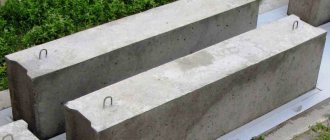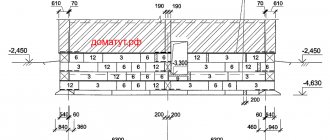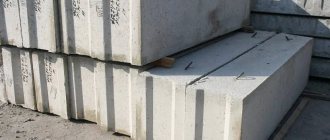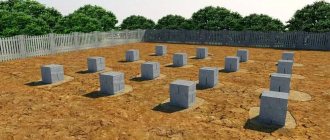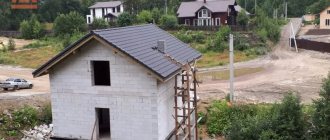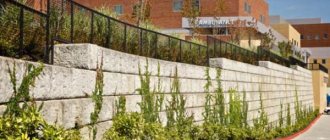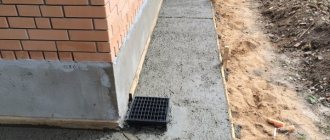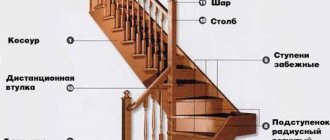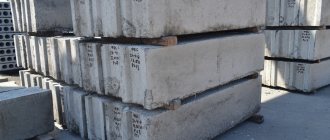When craftsmen study the sizes of FBS blocks, a table with all the values can greatly facilitate the process of performing calculations and provide all the necessary information. After all, before carrying out repair and construction work, everything must be very accurately calculated and designed, included in the plan and estimate.
FBS stands for “solid foundation blocks.” The construction of a foundation is a very important and responsible event, the correctness of which determines the strength, reliability, and durability of the future building. FBS blocks are usually used to create prefabricated foundations; they are made from high-quality raw materials, in strict accordance with GOST and standards.
Foundation blocks are made from different concretes: dense silicate, expanded clay, ordinary, heavy. The main function of the FBS is the creation of prefabricated foundations, the construction of basement walls and ground floors. Concrete blocks allow you to quickly and efficiently install a foundation, which in terms of technical characteristics will be inferior only to monolithic reinforced concrete.
The use of FBS in both low-rise and high-rise construction is relevant. Foundations made from blocks can withstand heavy loads and are suitable for houses made of different materials. Due to the fact that FBS is made from concrete with an iron frame, and installation involves the most reliable fastening, the base is strong.
Standard blocks are produced in the form of a parallelepiped. Their main advantage in construction is a significant reduction in the construction time of the foundation and a reduction in the total cost of work. Thanks to correctly mounted foundation blocks, it is possible to evenly distribute the perceived loads, creating the most reliable, durable, stable base structure.
Characteristics and features of FBS foundation blocks
FBS is produced from concrete mortar with a density from 1800 to 2400 kg/m3. The specification assumes the following three mixture options: with a strength above B7.5 (grade M100), at least B12.5 (grade M15), heavy concrete with strength from B3.5 (grade M50) to B15 (grade M200).
The resistance to low temperatures demonstrated by FBS must be at least F50 (which means that the foundation block can withstand a minimum of 50 freeze/thaw cycles). The optimal level of moisture resistance is W2, the thermal conductivity of the block is quite high, but this is not a problem for the foundation.
When indicating the size of the FBS, indicate its size in decimeters, rounding up. In addition to the dimensions, they also indicate the type of concrete from which the FBS is made: heavy (T), silicate (S), expanded clay (P, with a porous base).
An example of decoding the markings of the FBS-24-4-6 T block: the size of the foundation block is 240 centimeters in length, 40 and 60 centimeters on the sides, it is made of heavy concrete. Marking can be done in different ways (with periods, hyphens, spaces), but always requires the indication of basic quantities.
The weight of the FBS starts from 260 kilograms, so the construction of the foundation is carried out exclusively with the use of special equipment; the work cannot be completed with your own hands.
In the construction of residential buildings, foundation blocks of short length are usually used; multi-storey and industrial buildings - the largest ones. In the production of blocks, a certain error in dimensions is allowed.
Permissible dimensional errors in the standard:
- Height/width – deviation up to 8 millimeters.
- Length – no more than 13 millimeters.
- Along the cutout - up to 5 millimeters.
When purchasing and selecting blocks, it is important to pay attention to the size and weight of the FBS. So, if the weight is below the specified value, and the dimensions are normal, this indicates the presence of void areas in the blocks, poor compaction of the material, which negatively affects its strength. It is better not to use such blocks in the construction of a foundation.
To facilitate the installation process, the blocks are produced with special metal eyes, which are placed on top. They are made from periodic metal profiles or steel. If necessary, you can order small blocks without hinges. According to GOST, there should be no cracks or deformations on the blocks. In addition to the main types, FBP, FBV and others are also produced for the construction of residential and public buildings.
Shallow block foundation for a house with stone walls
Shallow strip foundation for a house with stone walls on medium-heaving soils. 1 - monolithic reinforced concrete base of the foundation; 2 - backfilling of the sinuses; 3 - sand and gravel anti-heaving cushion; 4 - reinforcement frame; 5 - blind area; 6 - backfilling the floor on the ground; 7 - horizontal waterproofing; 8 - house wall
The width of the base of the foundation of a house with stone walls, as a rule, is greater than the thickness of the walls. For these conditions, it is advantageous to make a monolithic reinforced strip of the base of a precast foundation of increased height. On top, on the base, lay the underground and above-ground (basement) parts of the foundation from small-format concrete blocks or bricks.
Pouring concrete for a monolithic foundation base directly into a trench, without formwork
On weak and medium heaving soils, it is advantageous to make the width of the trench equal to the width of the base of the foundation. Concrete is poured into the trench at random, without formwork. A reinforcement cage is first installed in the trench. This method is suitable for fairly dense soils in which the vertical walls of the trenches do not crumble.
On medium-heaving soils, sheets of insulation, extruded polystyrene foam 40 mm thick, are fixed to the trench walls. A layer of insulation separates the concrete from the soil, which reduces the impact of the tangential forces of frost heaving on the foundation walls. This solution allows you to avoid backfilling the sinuses of the foundation trenches. In addition, the insulation increases the heat transfer resistance of the basement part of the building and reduces the freezing of the soil under the base of the foundation. The insulation layer also acts as waterproofing for the foundation.
For a house with stone walls, in areas without a strong slope, it is enough to deepen the base of the foundation 0.3-0.4 m from the surface of the earth.
Products for construction and repair
⇆
Commentary on the video. When pouring concrete directly into a trench, the monolithic foundation strip can be left without waterproofing. It is not necessary to line the trench with film, as some do. In this option, waterproofing is installed higher, at the level of the masonry of the plinth blocks. The protective layer of concrete between the soil and the reinforcement at the base of the foundation must be at least 70 mm.
The height of the base during construction in areas with high snow cover must be increased. For laying a high base, it is advantageous to use concrete or expanded clay concrete small-format blocks. The outside of the masonry is insulated with sheets of extruded polystyrene foam. When laying a foundation on heaving soils, a layer of insulation is also laid under the blind area.
Sand cushion for prefabricated block foundation
A cushion of non-heaving sandy soil is always placed under the foundation strip. On non-heaving and slightly heaving soils, the sand cushion serves as a leveling layer.
When constructing a foundation on medium or more heaving soils, the sand cushion is already anti-heaving. The cushion increases the load-bearing capacity and reduces heaving deformations of the underlying soil.
To reduce the effects of frost heaving forces, an anti-heaving sand and gravel cushion is installed under the foundation.
The height of the sand cushion (dimension
h in the figure) is determined by calculation.
For most medium-heaving soils, the thickness of the sand cushion is in the range of 0.3-0.5 m. The sand-gravel mixture is laid in layers no more than 20 cm thick. Each layer is carefully compacted. For a non-buried foundation (in the figure), the thickness of the anti-heaving cushion is increased on medium heaving soils to 0.6 m. The width of the sand cushion should be at least 200 mm wider than the base of the foundation (dimension b ). from each side.
Prefabricated block shallow foundation made of concrete blocks with an increased width of the base
The width of the monolithic foundation base (dimension b in the figure) is determined by calculation. The width of the sole may be greater than the thickness of the foundation wall.
Advantages and disadvantages
When choosing the appropriate size of FBS foundation blocks and performing calculations for them, it is important to study all the features of the material, the pros and cons that need to be taken into account in construction.
The main advantages of using FBS:
- High quality of all products manufactured in strict accordance with GOST standards.
- Strict control of the entire technological process during production, which guarantees reliability and durability, compliance with the specified technical characteristics.
- Quick installation - erecting a foundation and walls from blocks takes literally a few days.
- Ease of operation - installation does not require any special knowledge or skills.
- Large selection of sizes - most often the height and width of the blocks are standard, but the length can be any. But if necessary, you can find elements with almost any width and other parameters.
- There are no complex requirements for operation - the blocks are not afraid of weather influences, aggressive environments, and can be used on wet soils.
- Long service life.
- Excellent indicators of frost resistance, resistance to moisture, fire safety.
Among the disadvantages of FBS, it is worth noting such as the need to use special equipment for installation (which increases the price of work), the importance of laying a layer of waterproofing between the joints, and the mandatory additional insulation.
When compared with a monolithic base, it is much stronger than a prefabricated one, but for many types of structures, a prefabricated base is a more economical and suitable option.
Foundation made of small-format blocks and bricks
In many cases, it is more practical and cheaper to lay the foundation of a house manually from small-format concrete blocks or bricks.
To lay the foundation of a house, concrete blocks (solid or hollow), as well as solid expanded clay concrete wall blocks or bricks are used
Scheme of a cheap block strip foundation for a house. The foundation is suitable for building a private house with walls made of any materials
Choosing block sizes
Block sizes can be very different. That is why designing a foundation is quite simple - choosing a FBS of the required size will not be difficult. When selecting dimensions, they take into account future loads that the foundation must withstand, as well as the need to distribute them evenly over the base.
The strength and load-bearing capacity of the structure, installation technology, implementation time of the “zero cycle” and the price of the foundation depend on the size of the FBS. Also take into account soil types and soil bearing capacity. Be sure to calculate in advance the thickness of the walls, floors of the building, the weight of the structure, strength and the required area of the foundation. The greater the weight of the structure and the less stability of the soil, the larger the foundation blocks you need to choose.
Thus, for clayey soils, large elements are chosen; for coarse soils, a base is created from small FBS. The most dense installation involves the use of elements of different sizes. When choosing blocks, remember this simple rule: it is optimal to have 5 blocks per length of the wall.
Prefabricated foundation reinforcement
To increase strength, reinforcement can be laid in the horizontal joints of the masonry in the foundation walls of any blocks.
Reinforcing mesh of 2 - 3 longitudinal rods of working reinforcement with a diameter of 10 - 12 mm is placed in monolithic belts and foundation soles.
Scheme of reinforcement of monolithic sections of the foundation. a - reinforcing mesh with two working reinforcement bars; b - the same, but with three rods. 1 - longitudinal rods of working reinforcement A-III, with a diameter of 10-12 mm; 2 — auxiliary fittings Вр-I, 4 mm in diameter.
In monolithic foundation strips, the distance between adjacent working reinforcement rods should not be more than 300 mm. If necessary, the number of rods is increased.
In the mesh of the monolithic tape with an increased width of the sole, additional rods of working reinforcement are installed transversely in increments of 600 mm . Vertical working rods with the same pitch are placed between the lower and upper meshes.
The protective layer of concrete between the soil and reinforcement in foundations must be at least 50-70 mm.
Scheme of reinforcement of a monolithic belt of a prefabricated foundation
Longitudinal and transverse reinforcement are fastened with knitting wire.
Don't leave your foundation unprotected over the winter
Protection from water and winter insulation of a prefabricated strip foundation made of concrete blocks. 1 - from top to bottom: loading layer of soil, film, insulation (foam plastic, bags of straw, sawdust), waterproofing of the soil and foundation tapes; 2 - waterproofing and insulation of the foundation according to the project; 3 - backfilling of the sinuses and embankment of the foundation strip with soil.
Shallow foundations should not be left unloaded for the winter if the walls and roof have not been built.
This is especially true for foundations on heaving and waterproof soils.
The lateral surface of foundations buried in the ground is affected by the tangential forces of frost heaving of the soil, which will push the unloaded foundation upward.
Under an unprotected foundation strip, the soil will freeze to a greater depth, significantly increasing its volume. In the spring, when it begins to thaw, the soil will sag unevenly and the foundation will not be able to return to its original place. All these processes often lead to cracking of the foundation.
If such a foundation is left unloaded for the winter—the house is not built—then the foundation and the soil near the foundation must be protected from water and freezing . The foundation and soil are insulated and covered with heat-insulating material - polystyrene foam, sawdust, straw, etc.
It is safer and more profitable to entrust the choice of a specific foundation design for a house to specialists. Doing it yourself will most likely lead to excessive cost increases.
construction as a result of reinsurance, or to a weak design, which will cost even more.
It is convenient to lay out the walls of the basement at the same time as the foundation using small-format concrete blocks. Find out everything about the size, waterproofing and insulation of the basement of the house.
Blocks. FBS. Concrete. Expanded clay concrete. PGS. Insulation boards. Foundation. Profiled geomembrane. Waterproofing. Fittings. Drainage. House. Tools
Next article:
Calculation of the dimensions of thermal insulation of a shallow foundation for a house
Previous article:
FBS blocks: product dimensions
Regardless of the brand used in the production of blocks, serial sizes are usually provided in standard sizes. If you need to purchase blocks of non-standard sizes, you need to order them at the factory or look for additional elements.
Standard FBS sizes:
- Length – 88, 118, 238 centimeters.
- Height – 28.58 centimeters.
- Width – 30, 40, 50, 60 centimeters.
Each block must have a marking indicating the length, width/height in decimeters. These parameters must comply with GOST 13579-78. The presence of letters next to the size indicates the type of concrete from which the elements are made.
GOST suggests that FSB is produced in 15 standard sizes. The main characteristic of the dimensions is the width, which varies from 30 to 60 centimeters. The length can be in three options, the height is usually standard (with the exception of a block with a length of 118 centimeters, the height of which is always 28 centimeters). The smallest size element has 88 centimeters in length, 30 in height and 58 in width, the largest - 238/60/58.
A standard block is a solid reinforced concrete product, without any voids. When choosing blocks, it is important to request a quality certificate from the manufacturer, which will guarantee that the blocks comply with the requirements of the standards.
Blocks of heavy and light concrete
Concrete.
GOST divides foundation concrete blocks into three types:
monolithic solid
(FBS),
solid with a recess
- for installing lintels and laying communications with subsequent pouring of concrete (FBV) and
hollow
(FBP).
The first ones are the most durable (the value of this indicator depends on the grade of concrete - from M 100 to M 200), can have a reinforcement cage and are available in a wide range of standard sizes. The maximum weight of products is 2 tons, density is 2500 kg/m³. The larger the dimensions of the concrete stones, the higher their strength and the greater the load they can withstand. The most popular size of blocks used in private housing construction is 40 × 20 × 20 cm, and their weight is about 32 kg, which allows masonry to be carried out without the use of heavy construction equipment.
Foundation concrete blocks
The second type of blocks, as a rule, is used for the construction of plinths, at the level of which utility networks are laid out. And finally, lightweight hollow blocks, due to air-filled cavities, provide improved thermal insulation, but due to their low load-bearing capacity they can only form the basis of small and light buildings, such as frame country houses, garden pavilions, greenhouses, etc.
A separate category of FBS consists of blocks of trapezoidal cross-section, marked FL and intended to create a substrate (also called a “cushion”) for the first row of foundation masonry: the expanded lower plane of the blocks forms an increased support area over which the load is distributed. Due to their special role in the design, such products are made from concrete with a strength of at least B12.5 and are necessarily reinforced.
Foundation blocks are made at concrete factories from high-quality components (in particular, without any admixture of clay), with precise adherence to their proportions, mechanical mixing and deep vibrocompression of the mass. The products strictly comply with the declared parameters of strength, frost resistance, etc., have the correct geometry and smooth surfaces
Cinder blocks.
They are made on the basis of a cement binder and fillers from industrial waste - brick and glass waste, fuel combustion products, stone screenings, etc. Moreover, the production of the material can be established without industrial equipment, using small vibration-pressing machines.
The products are heavy, do not differ in dimensional accuracy and are difficult to process, but they attract developers with their low cost. Only solid blocks are suitable for the construction of foundations, but they are not able to bear a load of more than 100 tons. It should be borne in mind that cinder blocks do not belong to the category of environmentally friendly materials (they may include unsafe components and impurities) and therefore are not recommended for use in construction residential buildings, their main area of application is outbuildings.
Expanded clay concrete foundation blocks
Expanded clay concrete.
This is a porous material with a fine-grained mineral filler (foamed clay granules, pumice gravel), which can be produced both in production and on a construction site.
It is light (the weight of small-sized blocks is 10–25 kg), has relatively low thermal conductivity and water absorption, but crumbles when cut and, due to its fragility, is less “hardy” than heavy concrete. Structural expanded clay blocks with a density of 1000 kg/m³ are usually used in the construction of foundations for small one-story houses, bathhouses, outbuildings, garages, etc.
Gas and foam concrete.
Both materials belong to the category of lightweight cellular concrete.
The first is produced using the autoclave method in factories, which ensures the accuracy of the block sizes and guarantees their quality. The second, which does not require autoclave processing, is often produced in a semi-handicraft way, and the compliance of such products with the declared characteristics can be questioned. Both gas and foam concrete have a low thermal conductivity coefficient, are easy to cut with ordinary hand tools, and are lightweight (block weight 30 kg). At the same time, they are hygroscopic, which means they need enhanced insulation from moisture and, due to their structure, have insufficient load-bearing capacity for supporting structures. However, when using material of high strength grades and mandatory reinforcement of the masonry in each row, foundations for light buildings can be laid from cellular concrete.
Foundation made of expanded clay concrete blocks
Foundation made of expanded clay concrete blocks
Foam block foundation
How to choose the right size of FBS blocks
A variety of blocks are used to create foundations. In order to accurately determine the dimensions and number of elements, a sweep of the base is made: on a special drawing, a conditional layout of all elements is performed along the length/height of the basement wall of the structure. The dressing between blocks should be at least 25 centimeters.
The width of the FBS is selected in accordance with the thickness of the building walls. According to the standard, a small overhang of above-ground structures is allowed. If you plan to build brick walls, the protrusion should be no more than 4 centimeters on the sides. It is allowed to use blocks 60 centimeters wide for walls 64 centimeters wide and blocks 50 for structures 51 centimeters wide.
The length of the FBS is determined based on the development, where elements of different lengths are placed so that they are mounted smoothly, without protrusions. It is advisable to have no more than 5 elements per wall.
As for height, products with a height of 58 centimeters are usually used for the construction of foundations and walls. Blocks 28 centimeters high are used as composite (additional) elements if it is necessary to make a hole in the foundation for the input/output of networks, vents, etc.
An important indicator is the mass of the FBS, which is important when choosing special equipment used for installation work. This parameter is also important when organizing the delivery of blocks to the site and loading/unloading elements. Without the use of special equipment, it is allowed to install only small-sized FBS measuring 20x20x40 centimeters.
How to lay FBS
In any row, laying begins from the corners. Then the blocks are placed in the places where the piers are drained. They are called lighthouses, and then all others are compared to them. Their vertical alignment is checked and corrections are made if necessary. Most often, the block must be lifted again, moved and replaced.
After the beacon elements are installed, the moorings are stretched - cords along which they are guided when installing the next blocks. They mark the boundaries of the wall, and so that the FBS stand symmetrically relative to the middle of the FL block (pillow block). The maximum permissible deviation is 12 mm. All subsequent rows of blocks should also be placed exactly above the middle.
When laying blocks, you must ensure that they are stacked one above the other without much displacement
It is more convenient to pull the cords 2-3 mm from the side surfaces of the lighthouse blocks. This will make it easier to display. Intermediate blocks are placed starting from the largest: first they put everything 2.4 meters long, then 1.2 and then 0.9. The correctness of their installation is checked against the marking cords, verticality - with a plumb line.
How to choose the sizes of FBS blocks
You can determine how many blocks you need for your foundation by selection. You can do this yourself on a plan drawn to scale. On the plan, you mark each block to the same scale.
The sizes of blocks for a FBS foundation are selected based on a simple rule: to increase the strength of the structure, you need to use the largest block sizes. Therefore, first you draw the 2.4 meter blocks installed in the corners, then, if they fit, draw them in the places where the partitions adjoin. Between them, you also place the largest blocks that can fit there. Where they no longer stand, place them in a smaller size. If there are any gaps that even the smallest block (0.9 meters) cannot fit into, don’t worry - these gaps are filled with brickwork.
Two types of prefabricated FBS strip foundations - with and without a cushion (shallow strip)
Draw the second row in a similar way, not forgetting about the displacement of the seams. If necessary, draw the third one in the same way. Then count the required number of blocks of each size. Do not throw away the resulting plan: it will be useful to you when installing the prefabricated foundation already on the site.
FBS masonry mortar
For laying foundation blocks, standard cement-sand mortar M-100 is used. It can be obtained using different cement grades and amounts of sand:
- For 1 part of M300 cement take 2.5 parts of sand;
- For 1 part of M400 cement there are already 3 parts of sand;
- when using M500 sand, add 4 parts.
First, mix the dry ingredients until a homogeneous composition and color is obtained. Then gradually add 0.5 parts of water. If the solution turns out to be too thick, add water little by little in small portions. The consistency should be like thick sour cream: not lumpy, but not runny either.
Do not try to increase the amount of cement. This will not only not increase the strength of concrete, as expected, but will significantly reduce it. To gain strength, concrete requires a strictly defined amount of aggregate (in this case sand) and water. If there is a lack of one and/or the other, its strength will be lower. In the worst case, it will crack and crumble.
Types of blocks according to GOST: FBS, FBP, FBV, FL and BF
For the construction of technical underground premises, the construction of basement walls, the installation of strip/column foundations, as well as the construction of walls of low (often unheated) buildings, and other structures operated at temperatures ranging from +50 to -70 degrees, three types of concrete blocks are traditionally used ( according to GOST 13579-78): FBS, FBP and FBV. They are made from heavy or silicate, as well as expanded clay concrete. The density of such products should be 1800 kg/m3 and higher.
FBS is a solid foundation block with maximum strength. Small products are not reinforced, they are only equipped with metal mounting loops. Dimensional blocks are reinforced with longitudinal steel rods, which significantly increases the weight and strength of building elements.
FBV blocks assume the presence of a longitudinal dimension in the product cavity itself. This cut is needed to install various utilities. Such products are produced using the same technology as FBS, but from concrete grade no lower than M100. Such blocks are rarely used in construction; they are usually ordered at the factory. Standard dimensions: length 88 centimeters, height 58 and width 40/50/60 centimeters.
FBP are hollow lightweight blocks with open square-shaped holes located at the bottom of the element. Blocks are produced from concrete grades no lower than M150, their standard length is 238 centimeters. Linear dimensions can be very different, which determines the cost of the product. FBP is used in the construction of foundations for industrial equipment and for arranging walls inside the basement.
There are also blocks marked FL, which have a trapezoidal shape and are usually used as a base for a strip/column type foundation. The dimensions and parameters of such unique “pillows” are regulated by GOST 13580-85. The height of the elements can be 30/50 centimeters, width - from 60 to 320 centimeters, length - 78-298 centimeters.
The smallest blocks have dimensions of 118 by 60 by 30 centimeters, the largest ones have dimensions of 298 by 200 by 50 centimeters.
BF blocks are used for the construction of external/internal walls of buildings of industrial and agricultural enterprises. Reinforced concrete strip blocks are produced from heavy concrete, in accordance with GOST 28737-90. There are only 6 types of block cross-sectional sizes.
Cheap strip foundation for a house with a basement
A cheap prefabricated strip foundation for a house with a basement can be made from hollow concrete blocks with vertical reinforcement of the basement walls.
For the foundation walls of a house with a basement, it is convenient to use vibro-pressed hollow concrete blocks - Besser blocks.
The presence of voids in the blocks makes it easy to perform vertical reinforcement of the foundation. The reinforced foundation can withstand lateral loads well. The option with vertical reinforcement is recommended for foundations with a basement.
Vertical reinforcement rods are placed in coaxial voids in the masonry blocks. Voids with reinforcement are filled with concrete of class B15.
To support the reinforced concrete slabs of the basement along the top of the foundation walls made of expanded clay concrete and hollow concrete blocks, it is necessary to make a monolithic reinforced concrete belt.
A monolithic reinforced belt along the top of a prefabricated foundation from any blocks should also be made for laying walls on them from blocks of aerated concrete (gas silicate) or porous ceramics.
Vertical reinforcement is made of hollow concrete blocks in the basement walls. To construct a monolithic reinforced concrete belt (banding beam), tray concrete blocks are used.
The monolithic foundation pad is connected to the lower row of hollow blocks using reinforcement outlets. All voids in the bottom row of blocks are filled with concrete.
For basement walls
It is recommended to fill all the voids in the blocks with concrete to the entire height of the wall.
If the foundation is without a basement,
then it is enough to fill the voids of the lower row of blocks with concrete, as well as reinforce and fill the vertical sections in the corners of the walls with concrete.
The sinuses of the foundation pit with the basement are filled with soil from the outside only after the installation of the floor slabs . Otherwise, under the influence of lateral soil pressure, the foundation walls may collapse.
A prefabricated foundation for a house with single-layer or double-layer walls is laid in one layer. The foundation for a three-layer house wall is also made of three layers - a load-bearing layer, an insulation layer and a cladding. The facing layer is made of narrow (12 cm) concrete blocks or solid ceramic bricks. The best material for cladding is clinker brick.
The thickness of the foundation walls is usually chosen to be the same as the thickness of the stone walls of the house. For a house with wooden or frame walls, the thickness of the foundation walls is made in the range of 250 - 300 mm.
Manufacturers and prices
Concrete products such as FBS and other blocks are produced by many concrete plants, so finding them in Moscow and the regions is not difficult. The production volume may vary, but all serious manufacturers guarantee high quality and adherence to technology in strict accordance with current GOSTs.
One of the largest manufacturers of FBS in Russia is the Industrial Construction Parts Plant. All products are manufactured in accordance with GOST standards, they are durable and of high quality; the average price of foundation blocks starts from 1,200 rubles per piece.
specializes in the creation of various concrete elements. The product range includes more than four hundred items, including various types of foundation blocks. The cost varies, depending on the size and type, on average it starts from 1650 rubles.
The products are of high quality. The plant creates various types of concrete blocks, the cost of which depends on the position, but is at a slightly lower level in comparison with other manufacturers.
The Alexandria expanded clay plant produces various types of concrete products. Small concrete blocks used in the creation of load-bearing walls, columns, fences, and also used as supporting elements of semi-basements, basements, and basement floors are in fairly high demand. All blocks are produced in special molds, which guarantees dimensional accuracy. The cost varies, depending on the type and size of the element.
The Zlatoust plant supplies good products to the construction market - the product range includes FBS, FVP, FBP, panels, stairs, road slabs and lintels. All concrete products are sold at an affordable price; the cost of a foundation block starts from 950 rubles per piece.
Waterproofing a prefabricated foundation
Profiled membrane under the foundation base
A profiled membrane under the base of the foundation of a private house serves as waterproofing, and also through the protrusions strengthens the connection of the foundation tape with the sand cushion.
The profiled membrane is a canvas made of high-density polyethylene (HDP) with protrusions molded on the surface (usually spherical or in the shape of a truncated cone) with a height of 7 up to 20 mm. Material is produced with a density from 400 to 1000 g/m2 and is supplied in rolls with a width of 0.5 to 3.0 m and a length of 20 m.
Due to the textured surface, the profiled membrane is securely fixed into the sand base without deforming or moving during installation. Fixed into a sand base, the profiled membrane provides a hard surface suitable for laying block and concrete.
The profiled membrane serves as waterproofing , preventing the suction of capillary moisture from the soil into the foundation strip. Foundation blocks are laid on top of the membrane on a layer of mortar or concrete is poured for a monolithic base. The protrusions of the membrane from the bottom side are pressed into the sand cushion, and from above through masonry mortar or concrete they are fixed in the foundation strip. Thus, the membrane strengthens the connection between the pillow and the foundation.
Previously, a different method was used for these purposes. A layer of crushed stone was compacted into the sand cushion, which was then poured with molten bitumen. In modern construction practice, it is easier and faster to roll out a roll of profiled membrane on top of a sand cushion .
Profiled membranes are also recommended for waterproofing floors on the ground.
To waterproof the side surfaces of the foundation of a house without a basement, it is enough to use coating waterproofing. Before applying the mastic, fill it with mortar and level the masonry seams. Bitumen-based mastic is applied in two layers to the height of backfilling with soil. From the outside - to the level of the blind area. From the inside - up to the floor level along the ground.
Horizontal waterproofing of walls in two levels
Horizontal waterproofing of masonry is made from rolled materials on a leveled base. It is recommended to arrange horizontal waterproofing in two levels.
The first layer of waterproofing is laid between the foundation and the plinth at the level of the blind area. This layer is connected to the vertical waterproofing of the foundation strip.
The second layer of waterproofing in the wall is made higher, between the base and the wall of the house, at the floor level of the first floor. The waterproofing of the floor on the ground is connected to the waterproofing of the wall.
When starting the construction of a private house on a site, it is necessary to choose the right vertical placement of the house - determine at what height to place the floor level of the first floor (basement height) and how to change the vertical layout of the soil at the construction site.
Correct planting of the house and vertical layout of the site are necessary to solve the following problems:
- Ensure that pits, trenches, cushions and foundations are located above the groundwater level.
- Drainage of storm and flood waters from the house and further outside the site.
- Placement of above-foundation structures (walls, basement floors) above the level of snow cover to protect them from moisture.
On construction sites, both with and without a slope, it is always necessary to provide and carry out an artificial increase in the ground level by adding extra soil. Before starting work, make a vertical layout of the site in order to drain atmospheric water from the built-up area.
Read: “Vertical layout of the construction site of a private house.”
During the installation of the foundation, melt and rain water may accumulate in the trenches. Building a house on weakened soil saturated with water is fraught with the appearance of cracks in the walls.
The process of constructing the foundation, from digging trenches to backfilling the sinuses and installing a blind area, must be completed in dry weather and in the shortest possible time.
Backfilling of the foundation sinuses is carried out with non-heaving soil with layer-by-layer compaction.
After completing the foundation work, be sure to immediately make a blind area. I recommend making drainage trays along the edge of the blind area. Drain water from gutters and roof drainage systems away from the house.
Dependence of the choice of block foundation on the characteristics of the site
Before designing a house, it is necessary to order a geodetic report on the features of the site.
You can, of course, get it from your neighbors, but it won’t be entirely reliable. Sometimes even neighboring areas differ greatly in soil, water, and other characteristics.
Priming
Textbook “Soils. Foundations. Choosing the optimal foundation" classifies soils as follows:
- Rocky soils are, rather, crystalline rock, rock rather than earth, and sedimentary rock (dolomite, compressed sandstone, shale, shell rock, limestone). Any foundation is acceptable except a pile foundation (it is difficult to drill into rock).
- Conglomerates are fragments of varieties of rocky soils; do not erode or change in volume when freezing; Any foundation is acceptable.
- Non-rocky soils:
- bound - clayey and loamy; freeze deeply; capable of “floating” and moving, only heavy types of foundations are suitable;
- unbound - sandy and sandy loam soils; when wet they tend to move and freeze shallowly; Any type of foundation is suitable.
Soil type may vary even in adjacent areas
If your site is a mass of rock, untouched sandstone or sedimentary rocks, then you can easily install a block foundation. It is also good if the soil of the site consists of sand or dense loamy soils.
Table: minimum foundation depth in sand and clay
| The soil | Minimum depth (m) | |
| 1 | Sand | 0,5 |
| 2 | Clay | 0,7 |
To get an approximate understanding of what soils are available on your site, there is an old-fashioned method: drill a hole with a garden drill and examine soil samples from different depths. The sample is moistened with water, and if it can be kneaded like dough, then it is loam. If the earth dissolves in water, it contains a large percentage of loamy component. If sediment falls, there is clay at the bottom and sand above it.
To test the soil, you need to place a sample in a glass of water.
Groundwater
The groundwater level is the most important characteristic of soils. If the level is small, then a shallow strip foundation made of blocks is perfect for us. If it is quite high, then the tape should be buried to a greater depth.
The structure of groundwater in your area has a huge impact on the choice of foundation type
Freezing depth
The freezing depth in our area is on average up to one meter, but deviations are possible. If you are making a deep foundation from blocks, then its lowest point should be below the freezing point of the soil.
The base of the foundation should be below the maximum freezing depth of the soil to prevent swelling of the soil when freezing. The safe depth depends on annual temperature variations, the type and range of local soil variations, and the normal groundwater level. In addition, seasonal changes in the volume of clay soils are sometimes observed, which should not be allowed under a foundation laid on a natural foundation.
Collier's Encyclopedia
https://dic.academic.ru
Freezing depth is a factor influencing the foundation depth
The most dangerous factor is directly related to the level of soil water and soil classification.
Water "lenses"
Where permeable sand or sandy loam lies on a layer of clay, precipitation penetrates through the upper soil and remains under it in the form of so-called “lenses” that lie on an impermeable base and can severely damage the foundation. You need to be sure that there will be no “lenses” on the way to laying the block foundation.
If there are “lenses” in the soil, only a pile-strip foundation is used
Choosing a foundation
The choice of the shape of the foundation made of blocks depends on all of the above factors - soil, water balance, the presence of lenses, freezing depth, combined into one geodetic conclusion. But it depends on your preferences, and on the blocks that you may already have, and even on the time of year. Therefore, you need to understand the main advantages, milestones and dangers of constructing each block foundation.
As we already know, there are two types of block foundations: columnar and strip.
- Strip foundations made of blocks can be shallow, non- and deeply buried.
It is built from expanded clay, foam and cinder blocks, concrete blocks, concrete panels laid on a bed of drainage mixture. Not very suitable for unreliable soils, but the problem is usually solved by deepening and widening the “ribbon”, laying a widened concrete or block base from cushion blocks and creating a permanent reinforced concrete grillage. The strip foundation, depending on the soil, can be shallow, deep or shallow - A columnar block foundation is perhaps the simplest and most inexpensive to construct.
It can also be shallow, non- and deeply buried and is also made from expanded clay, foam and cinder blocks, concrete blocks, concrete panels (non-monolithic pillars), laid in pits (if the pillar is buried) or simply on the ground (if not buried) on a bed of drainage mixtures. Suitable for light buildings such as frame houses, gazebos and greenhouses and any soil except swampy ones. When constructing a shallow columnar foundation from blocks, a wooden grillage is used
How to make a strip foundation from concrete blocks
An important stage in the construction of the foundation of a house is design, which is usually entrusted to civil engineers. When constructing small non-residential buildings, you can use an online design computer program. Most often, the width of the first row of a block structure is 40 cm, the upper rows are 30 cm. If you plan to output communication systems through the base of the house, you must purchase blocks with pre-fabricated holes.
When preparing the construction site, a place is provided for the installation of a truck crane, with the help of which the foundation blocks will be laid.
Stages of constructing a trench for the foundation:
- The corners of the building structure are determined and stakes are driven in.
- Stretch twine between the stakes.
- Install pegs in the future locations of the walls.
- They dig a trench, the depth of which usually exceeds the freezing depth by 200-250 mm.
Why do you need a foundation?
The term "foundation" comes from Latin. "Fundamentum" means "foundation".
Foundation is an underground or underwater part of a structure that transfers to its soil foundation the static load created by the weight of the structure, and additional dynamic loads created by wind or the movement of water, people, equipment or vehicles. A properly designed foundation transfers all loads to the ground in such a way that the possibility of unacceptable settlement and destruction of the structure is eliminated.
Collier's Encyclopedia
https://dic.academic.ru
Foundations save the house from manifestations of the “bad character” of complex soils and not only from groundwater, but also from ordinary, “regular” precipitation. The foundation must support the weight of the building. You can build a luxurious and very expensive house, but if the design, depth and material of the foundation were chosen incorrectly, even on the most favorable soil the building will settle and crack. Before building a foundation from blocks, you need to make sure that it is suitable for the given structure.
